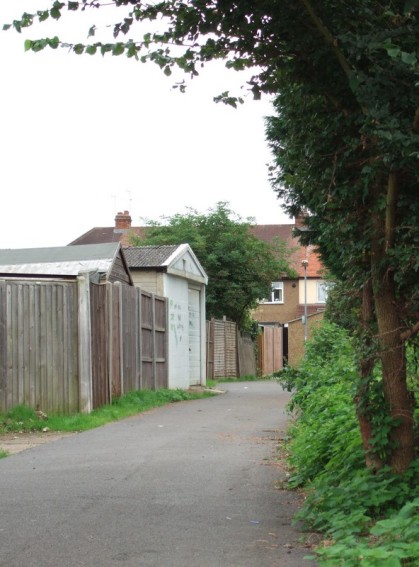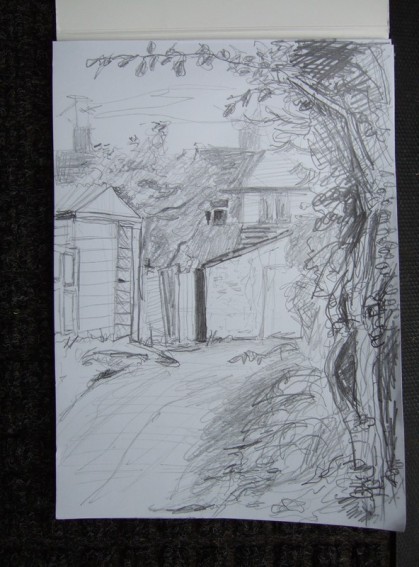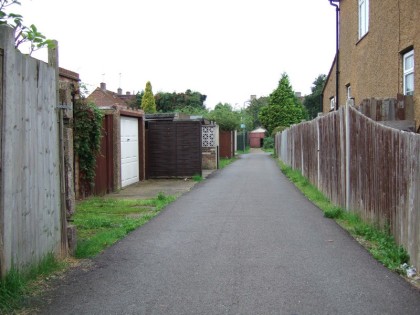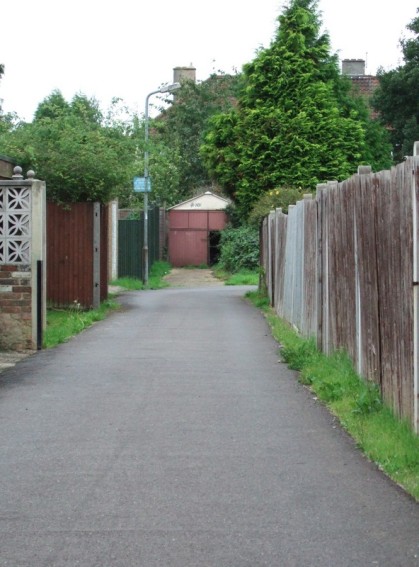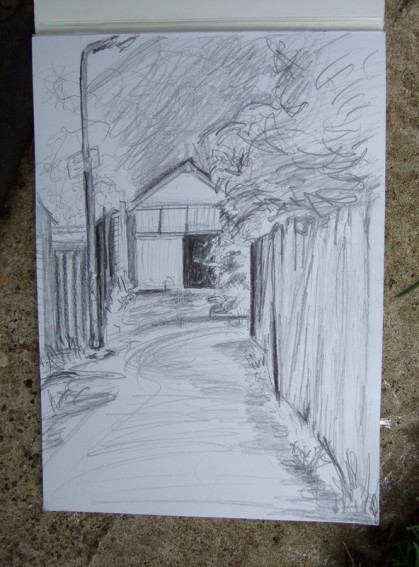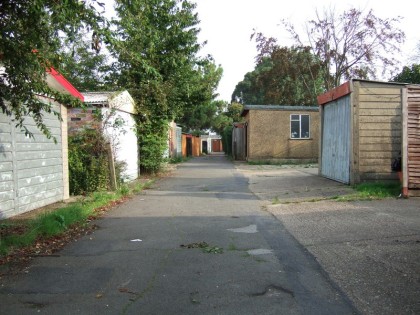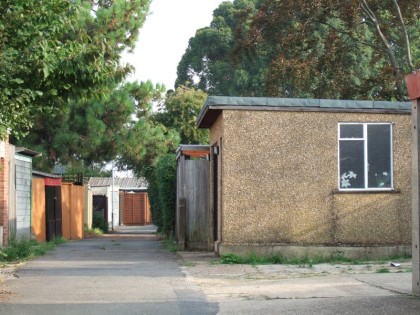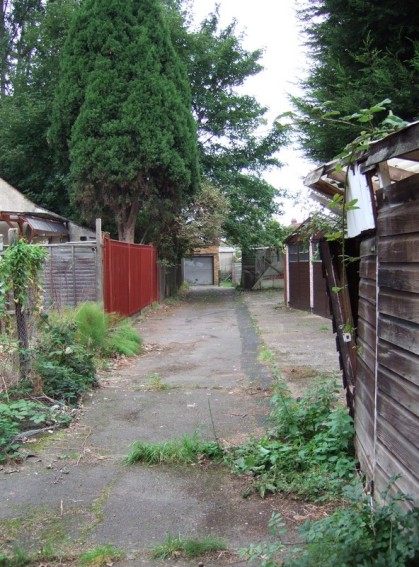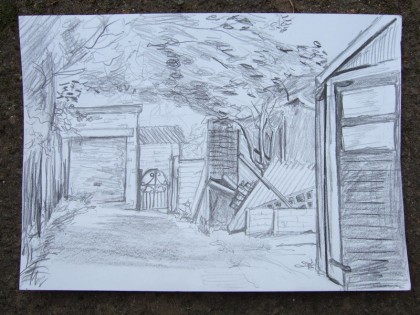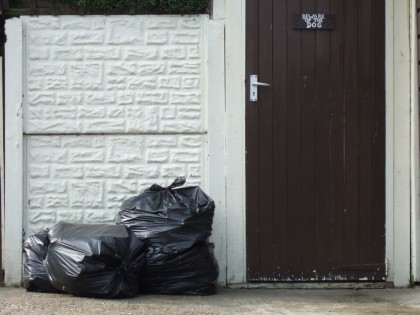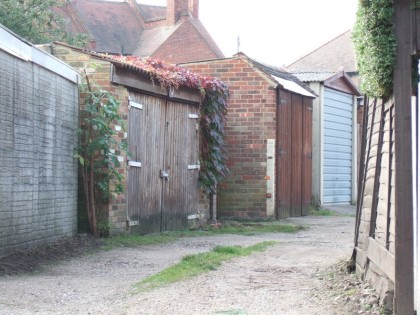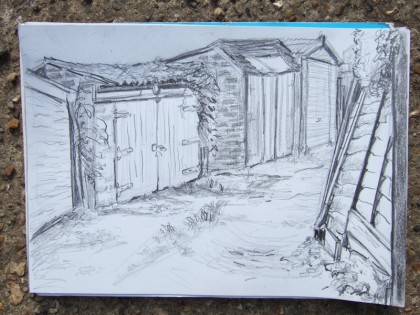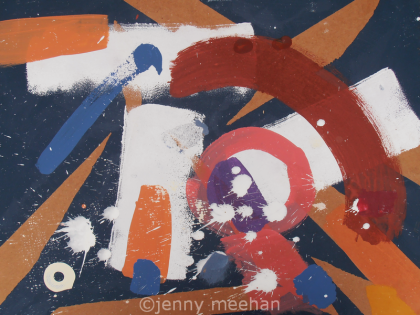
No Fear painting 2016 by Jenny Meehan ©jenny meehan
Well, another month, another post!
February 2018 Art Journal Post by Jenny Meehan
Quite late to post February post on the 19th!
The older you get the quicker time flies! Indeed, I am mid month, and only just posting this entry! For time may have wings, but I don’t.
It’s great to be able to walk now! (March 8th, last year…Total Knee Replacement!!!) Bit random, I know, but I’m so very very grateful. Mobility is so precious.
This journal serves as a tool for my creative practice. It’s a reason to write with a deadline, of sorts, and keeps me writing, reviewing, thinking, and having a space to think and reflect, as well as enabling me to share snippets of what I am up to with my visual art practice. I throw in a poem here and there, and chew over random thoughts from time to time. I share paintings, drawings and photographs, both past and present. Sometimes those in progress and those which seem finished.
Though I keep my website reasonably tidy and succinct, on this Jenny Meehan Contemporary Artist’s Journey, I take my meandering discourse wherever it will go. Great fun. Not a perfected piece of writing but a narrative, partly to myself and partly to you. A note book of a kind. A discipline. A record. A way of me looking back from time to time to reflect on what I have been thinking and doing, how things have changed, how they are the same, and simply just wondering.
I have always enjoyed the stream of consciousness writing form, so while I do edit this journal a little bit, the overarching idea is I just write whatever I fancy at the time and don’t worry very much at all about structuring it. It’s a bit of a collage I think. I hope it serves as some kind of insight into my visual art activities and it provides some release for me in terms of enjoying very much the process of writing, researching and reflecting. It’s not a solid and it’s not a gas.. It’s a liquid. Not order. Not chaos. Somewhere in between!
Unfortunately this cannot be said for my studio tent, which does need some attention. It’s nice for the flowers to have somewhere to grow though!
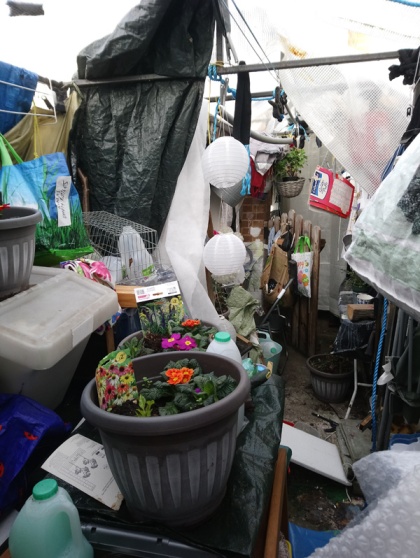
studio tent jenny meehan
Time to tidy up, before March, when it gets (hopefully) warmer!
“Vibe Drome”: One Small Piece of the Small World Futures project!
Image of the Small World Futures contribution from myself!
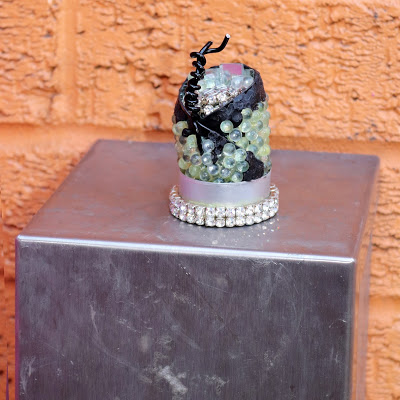
Image credit: ©Alban Low
The “Vibe Drome” (My nick name for this world!) is taking part in the “Small World Futures” exhibition at the Unsettled Gallery, London Bridge. Look out for it, and if you find it, be careful…It may pick you up!
Many other interesting pieces to be found! Hopefully, if they stay there for long. Let’s hope they do!
Here is some text quoted from the CollectConnect website:
“Here at ColllectConnect we’re starting 2018 with a fascinating little exhibition. Small World Futures is a collection of 38 miniature sculptures depicting what life could look like in years to come. Each of these small artworks will be placed in public spaces (#unsettledgallery) around London Bridge. Every day throughout February we will be featuring one of these worlds here on the website. A writer will also use the world as an inspiration to create something new and fresh, their words describing the shape of a new world.
In the autumn of 2017 Dean Reddick and Alban Low began cultivating a series of public exhibition spaces around London Bridge called the #unsettledgallery. These include flowerbeds, railings and gates, as well as spaces between bricks, in gullies and beside drainpipes – basically anywhere an artwork can rest and be seen by the public. Although these spaces change and evolve on a daily basis, several housed artworks for a longer period of time. The Small World Futures will find their homes in these public spaces. They may stay there for an hour or a week. Perhaps they will plant a seed of an idea in the people who see them.”
I did write my own text for the Vibe Drome, but I have kept that under covers so that my own ideas don’t influence anyone else’s. Take a look at the blog to see more on the project and lots of fabulous future worlds with the writing which they have helped to inspire!
http://collectconnect.blogspot.co.uk/
And here is the delightful poem to accompany it, by Natalie Low:
Today we discover the Small World Future of…. Jenny Meehan
The year is 5,000,000,000 AD
Twinkle twinkle dying star
No escape from what you are
Hanging limply in the sky
Watching us all wave bye-bye
Twinkle twinkle dying star
Au revoir our ex-solar.
Now your light and fire are gone
Earth’s too cold to live upon
You can’t blame the human race
Off to try another place
Twinkle twinkle dying star
Au revoir our ex-solar.
© Natalie Low
(Included on here with permission from Natalie Low)
I will be going to visit it in person very soon. Hopefully it will still be there! It looks like it is worth something due to the shiny parts. My earnest wish is that a magpie in need of some bling might locate it and take part of it away for its nest. I think anyone picking it up in search of worldly wealth is going to be very disappointed. Damien Hirst may well have been able to use real diamonds on his skull, but my sculpture is, quite literally, a world apart. Some information from Wiki on Damien Hirst’s skull:
“For the Love of God is a sculpture by artist Damien Hirst produced in 2007. It consists of a platinum cast of an 18th-century human skull encrusted with 8,601 flawless diamonds, including a pear-shaped pink diamond located in the forehead that is known as the Skull Star Diamond. The skull’s teeth are original, and were purchased by Hirst in London. The artwork is a Memento mori, or reminder of the mortality of the viewer. Costing £14 million to produce, the work was placed on its inaugural display at the White Cube gallery in London in an exhibition Beyond belief with an asking price of £50 million. This would have been the highest price ever paid for a single work by a living artist.[2]”
Rather than inhibit an interior space, I am hoping that my piece dies a natural death, remains in its place, and looses its worthless jewels in the beak of a magpie. I have to say, I have never seen a magpie around the London Bridge area, but you never know, there may be a small chance!
Do take a look at Alban Low’s website too. He’s doing great work in a variety of ways!
He’s busy sketching on the radio at A World In London at Resonance FM nearly every week, as well as plenty of gigs around London. Have a look at http://artofjazz.blogspot.co.uk/
I love his drawing!
Why Abstract Painting Isn’t Music
https://philosophynow.org/issues/50/Why_Abstract_Painting_Isnt_Music
Patricia Railing on the point of abstract art, and on how it works. I am reading through and reflecting on this. It’s one of the best pieces of writing on painting I have come across in a long time!
NOTE: I have emboldened some areas for my own notes, this is not in original text.
“A recent exhibition in Paris at the Musée d’Orsay, entitled At the Origins of Abstraction (Aux Origines de l’abstraction), explained the advent and practice of abstract painting at the beginning of the 20th century as the ‘translation of music’. Thus continues into our new century the widespread misunderstanding of the early abstraction of ‘pure painting’ and of the relationship between painting and music.
Certainly there were composers who wrote scores accompanied by colour-light shows (e.g., Scriabin and Rimsky-Korsakov) and painters like Ciurlionis who wrote scores as sound compositions of their paintings. This correspondence between the arts issued largely from Symbolism and had been inspired by scientific studies of colours and tones as sensations. The ‘pure’ painters – Vasily Kandinsky, Frank Kupka, Piet Mondrian and Kazimir Malevich – who followed after 1910, however, always declared that their paintings were not music, nor that they were painting music. Rather, they claimed that painting’s colours have an effect on the human being just as music’s tones do: the relationship between music and painting is a parallel one, colour and tone affecting and enlivening human feelings.
Painting and Music Play on the Instrument of the Feelings
It is the feelings, then, that are the ‘instrument’ on which colours and tones play their tunes. The media are different but both set the feelings in motion, giving them a particular kind and quality. In his 1912, Concerning the Spiritual in Art, Kandinsky wrote: “Generally speaking, colour is a power which directly influences the soul (i.e., the feelings). Colour is the keyboard, the eyes are the hammers, the soul is the piano with many strings. The artist is the hand which plays, touching one key or another, to cause vibrations in the soul.” (Dover Publications, p.25). It was Schopenhauer who had inspired this image of the feelings, writing: “We ourselves are now the vibrating string that is stretched and plucked” by pleasure and pain, by harmony and dissonance. (The World as Will and Representation, Vol. II, p.451.)
References to music abound in Kandinsky’s book, and he gave musical titles to three groups of work between 1909 and 1914: Improvisations, Impressions, and Compositions. Frank Kupka also titled a few of his works with the musical terms of Nocturne and Fugue. So critics at the time, standing before works the likes of which they had never seen in their lives, latched on to the musical theme and explained this abstract painting in terms of music. This was so frequent that Kandinsky was compelled to state in a 1913 catalogue and a 1914 lecture: “I do not want to paint music. I do not want to paint states of mind.” Rather, it had to be understood that the “laws of harmonics in painting and music are the same”, to borrow the title of Henri Rovel’s article of 1908 in Les Tendances nouvelles.
This parallelism of the arts of painting and music was based, on the one hand, on their inner creative laws and, on the other hand, on their effects in the human realm of feeling (called the soul). This is neatly illustrated by Kandinsky and by Franz Marc in letters of January 1911 after they had attended a concert of the music of Arnold Schoenberg. Remarking particularly on the composer’s 1909 Three Piano Pieces, Kandinsky wrote to Schoenberg: “The independent progress through their own destinies, the independent life of the individual voices in your compositions, is exactly what I am trying to find in my paintings.” What Kandinsky meant is made clearer by Franz Marc, writing to Auguste Macke: “Can you imagine a music in which tonality (i.e., the adherence to any key) is completely suspended? I was constantly reminded of Kandinsky’s Composition [see Illustration], which also permits no trace of tonality, and also of Kandinsky’s ‘jumping spots’, in hearing this music, which allows each tone sounded to stand on its own (a kind of white canvas between the spots of color!)”. (In Schoenberg, Kandinsky, and the Blue Rider, Scala, 2003, p.25 and p.21.) Applied to his painting, Kandinsky’s ‘jumping spots’ of colour allow each colour to stand on its own, independent of colour tonality. To feel the content of each tone or each colour, to feel their ‘independent voices’, is one of the essential creative aims of the abstract arts of music and of painting around 1910.
Composition
Why should artists want to tap the feelings in this way? This is a broad issue and part of the Zeitgeist of the late 19th and early 20th centuries. Two aspects of this are particularly relevant. First of all, artists wanted to see behind appearance, or rather, they wanted to see the realities that create appearance, at a time when publications on the new physics were providing a new understanding of creation itself. Secondly, the artists were among the first to explore another reality: that of colour itself and tone itself, together with their effects on the human being. This was based on the many 19th century publications by experimental scientists like Helmholtz, Wilhelm Wundt, Freud, Mach and others. The premise of this work was that the nerve-sense system is a dynamic system in constant movement, receiving and responding to stimulae, called sensations, which are found to directly affect the feelings and hence states of mind. This field of exploration, called psycho-physiology, informed Kandinsky’s Concerning the Spiritual in Art, Kupka’s Creation in the Plastic Arts, Malevich’s writings, and traces are also found in Mondrian’s writings. The metaphor that the feelings are like a musical instrument playing the songs of life allowed artists to take a new look at their media. Scientists were asserting that colours and tones have direct and verifiable effects on every individual, so artists set about exploring the vast artistic realm of sensation and feeling through colour and tone, and this resulted in a new form of artistic expression. Artists could play on the harp of the soul, plucking now one string, now another, now sounding them together. This inner music, “in which tonality is completely suspended,” in which “jumping spots allow each tone sounded [or painted] to stand on its own,” was the touching of the soul (the feelings) directly. The created work was thus pure music or pure painting, having no intermediary and no intrusion from the world of thought in the form of any kind of imitation (mythology, religious philosophy, history or genre). It was the pure music or the pure painting of pure feeling in the artist’s use of colours and tones, stimulating pure feeling in the spectator.
All is Energy
But what were the ‘laws of harmonics’ that stood behind the creation of pure painting and pure music and that were common to both? Essential to them is that they were based on yet another component of the early 20th century Zeitgeist: the world-view that all is energy, dynamism, movement. This was asserted by the new physics of Einstein (1905 and 1916), Maxwell’s treatises on electromagnetism (1870s), Max Planck’s paper on quantum theory in 1900, Poincaré’s works, and so many others. Thus, the laws of harmonics – by which is meant the laws of constructing music and painting – are to be found in the laws of movement, dynamism and the expression of energy. The laws of construction are the forming processes of music and of painting, and they are parallel to the forming processes found in all reality. As music is the art of movement itself, and painting had always been thought of as a static art, it was to the language of music that painters turned for want of a traditional vocabulary of movement.
The Constructive Laws of Rhythm
‘Rhythm’ is music’s most basic component. Tone moves according to rhythm, but colours in a painting are also arranged according to rhythm. The same is true for poetry. In How Verses Are Made (1926) the Russian poet, Vladimir Mayakovsky, wrote: “I went along, swinging my arms and mumbling almost incoherently, now slowing down so as not to disturb my mumbling, now mumbling quicker in order to keep time with my feet. That is the way to shape and plane rhythm, the basis of all poetry, which runs through it in the form of a subdued roar. Gradually, you begin to extract individual words from the roar.” And in the same year the German painter/poet/composer/builder, Kurt Schwitters, noted:
“What art is you know as well as I do: it is nothing more than rhythm. And if that’s true, I … can modestly and simply give you rhythm, in any material whatsoever: bus tickets, oil paints, building blocks, that’s right, you heard me, building blocks, or words in poetry, or sounds in music, or you just name it. That’s why you mustn’t look too hard at the material; because that isn’t what it’s all about…. [Just] try, in spite of the unusual materials, to catch the rhythm of the forms and the colours…. Every artwork throughout history has had to fulfill this primary requirement: to be rhythm, or else it isn’t art.” (In poems performance pieces proses plays poetics, Cambridge, MA., Exact Change, 2002, p.229.)
In nature, rhythm is the manifestation of energy in its forming process, and it functions according to one of two fundamental laws: that of progression, and that of the contrast of forces; usually they are found together. Progression is always numerical and/or geometrical, as in the Fibonacci series, while the contrast of forces is the law of polarity, those forces of the centrifugal/centripetal, push/pull, the attraction/repulsion of electromagnetism. In art, rhythm is also the manifestation of energy in the forming, creative process. The law of numerical progression had been the fundamental creative means of classical Western music; in painting it is found in perspective – geometrical – and proportion – numerical. When artists like Schoenberg and Kandinsky began to use the law of the contrast of forces rather than that of progression, music and painting became subject to entirely different rules of rhythm and, hence, to entirely different rules of harmony, made up of consonance, the means according to which the law functions, and dissonance, the necessary opposite of consonance.
In the creative law of numerical and geometrical progression, consonance is determined by adherence to the particular order or structure of progression; dissonance is introduced when that order or structure is violated. When an artist creates using the energy of polarities, the law of contrasts – of tones or of colours push-pulling, attracting and repelling – consonance is that state of balance between the two forces while dissonance is that state of imbalance between the two forces when one or the other increases or decreases its energy. Movement or dynamism then take the place of a state of rest, allowing change to occur. Because of the innate dynamism of polarities, the term ‘dissonance’ became an alternative word for ‘creativity’ for many artists. Thus would Kandinsky write to Schoenberg in his letter of January 1911:
“I am certain that our own modern harmony is not to be found in the ‘geometric’ way, but rather in the anti-geometric, anti-logical way. And this way is that of ‘dissonances in art’, in painting, therefore, just as much as in music. And ‘today’s’ dissonance in painting and music is merely the consonance of ‘tomorrow’.”
It is interesting to note here Schoenberg’s interpretation of the term ‘anti-logical’ in his reply to Kandinsky, writing that it is what “I call the elimination of the conscious will in art.” Around 1910, art was rejecting cultural anecdotes of whatever subject matter, no longer constructing according to linear, intellectual progression, and becoming instead a means of revealing the very nature of the human being, a being that is dynamic, continuously ignited by contrast in the feelings, in thinking and in life itself. Art gave expression to, and extended, the potential of this vast creative realm, the realm from which the human being extends into the world and creates it.
Rhythm is innate to the human being, to the breath and to the heartbeat. It is innate to the very existence of nature and the universe. Rhythm, for so many early 20th century artists, was the heartbeat of all reality and it was the very substance of Frank Kupka’s art. Drawing on Henri Bergson’s Creative Evolution, and on many scientific publications, Kupka made visible the invisible forces of growth in nature, the universe and in the physical human body. These forces – taking the shape of the spiral, the triangle, the vertical and the horizontal – are both the scaffolding of everything that exists and the means of its creative laws. They are so, they are both particle/form and wave/energy, because they are determined by rhythm. Catching the rhythm meant catching the chord which holds together the human body, nature and the universe, meant catching the energy that creates.
Rhythm is not a thing: it can only act through things. For the painting-composer these things are colours and forms, for the music-composer they are tones. We shall consider painting only.
To begin with colour. In their writings, Kandinsky, Kupka and Mondrian all describe how colours function both optically and in the realm of feelings and, therefore, how they can be used to set up many, many kinds of rhythms. As Kupka wrote in Creation in the Plastic Arts, “The radiation of vital energy in nature, and of the same energy which dwells inside us, always manifests itself through the relationships between different vibrations and, therefore, between different colours.” (Liverpool University Press, p.87.) Scientists had shown how long exposure to certain reds made the subject anxious or angry, for example. In Concerning the Spiritual in Art Kandinsky writes that the intensification of a certain yellow “increases the painful shrillness of its note” (p.68). And Kupka says in Creation in the Plastic Arts that violet is “a mixture of passion and reason, is the colour of thought and of bishops” (p.86). Playing the strings of the feelings meant playing the effects of the colours on the feelings. And suddenly, the painting becomes active and activated, the spectator experiencing the light vibrancy or heavy thud of ‘jumping spots’ and, in the case of Kupka, say, a swirling of blues where inner movement is harmonious and pleasant.
Forms, too, affect the feelings. Kandinsky did studies on the effects of shape, concluding that the pointed triangle made a different impression on the subject than the curved circle, and he published his findings in 1926 in Point and Line to Plane whilst at the Bauhaus. Colouring the pointed triangle yellow or red produced yet another effect on the observer, one being harmonious and satisfying, the other like a conflict between two forces and thus producing another feeling. It is precisely in the law of forces, whether they are consonant or dissonant, that the laws of harmonies are found. Rhythm is an expression of these forces.
Painting, then, has a ‘grammar’ of colours and of forms, to use Kandinsky’s word. Simple and straightforward as the grammar itself might be, it allows great complexity of expression, just as the written and spoken grammar of words does. We have only to compare the painting of Kandinsky and Mondrian: Kandinsky’s Composition II (1910, destroyed) was full of colour energies in animated, painterly movement, while Mondrian’s compositions with the primary colours of red, yellow and blue (1920s and 1930s) were made of few colours in flat planes held within a few horizontal or vertical bands. The former work is visually dynamic, the latter are visually static. The former has many loud or breezy rhythms rushing about, the latter have quiet, even silent, rhythms, especially noticeable in the white and black paintings such as Composition II with Black Lines, 1930 (Stedelijk Van Abbemuseum, Eindhoven). All these rhythms we feel, played as they are on the instrument of our soul, our feelings. These paintings do not come from music, they are not the translated tones of Schoenberg’s Three Piano Pieces or any other musical composition. But like anything that makes the soul sing – or weep or jump or dance – they can be called ‘musical’, if that is understood as only a metaphor for organised movement and dynamism.
Pure Painting, Pure Aesthetics
Consonance and dissonance of rhythm in pure painting, the play between contrasting forces and their coherence or unity, was for Vasily Kandinsky the basis of the new ‘harmony’, as he concluded in Concerning the Spiritual in Art. Kazimir Malevich called consonance and dissonance and their unity in the work of art the ‘new aesthetic’, in the opening paragraph of his 1919, On New Systems in Art / Statics & Speed. Malevich writes that this new aesthetic, this new means of affecting the feelings directly through artistic means, is seen in nature by the artist as “painterly masses in motion and at rest, … the unity of diverse painterly forms; … the symmetry and harmony of contrasting elements”, the painter rejoicing in nature’s “flow of forces and their harmony”. Similarly, sitting before his canvas, the painter:
“regulates the flowing forces of colour and painterly energy in a multiplicity of forms, lines, planes; he also creates forms and the different elements of their signs and achieves a unity of contrasts on the surface of his picture. Thus the creation of contrasts between forms leads to a single harmony in the body of the construction without which creation would be inconceivable.” (In Malevich on Suprematism, University of Iowa Museum of Art, 1999, p.55.)
And all this because the contrasts set up by consonance and dissonance produce a harmony of the feelings. Pure painting had led to pure aesthetics, one that was of and for the feelings alone (without the intervention of thinking through mimesis), while awakening consciousness, the mind. This is why artists claimed that art was finally fulfilling its true task.
Since painting had become abstract after 1910, it could certainly be talked about in the same way as Schopenhauer had described music. Abstract painting was rhythm touching the feelings directly so now, it too, like music, was a ‘copy of the world will’. No longer passing through objects of the world but passing over them, no longer depicting only fragments of reality, abstract painting, like music, was independent of the phenomenal world of objects. Abstract painting objectifies the will itself, directly (no longer indirectly through ‘mimesis’, the imitation of the phenomenal world) through its artistic means and their arrangement, also like music.
Abstract painting, however, had taken a further step: because it embodies pure rhythm, which takes place in time, whilst existing as an object in space, abstract art brought time and space together in a way that had been inconceivable for Schopenhauer and 19th century painting and sculpture. Abstract art was a reconciliation of fundamental opposites. As the union of space and time, abstraction was both ‘representation’, or pure forms, and ‘will’, or pure energy, it was particular and universal, it was material and essence – that essence that sings its way through all eternity in every living thing.”
© Patricia Railing 2005
Dr Patricia Railing has published widely on early 20th century abstract art. She is director of Artists.Bookworks which publishes artists’ books and writings of the early 20th century. See: https://artistsbookworks.co.uk/
This piece was originally published in Philosophy Now Issue 50, as follows: https://philosophynow.org/issues/50/Why_Abstract_Painting_Isnt_Music
Included in this blog by kind permission.
I am delighted to find this article and I find it vastly helpful and insightful. It certainly describes excellently what my painting means to me and how I see it functioning. It is amusing to me that I have recently started learning African hand drumming and am very excited about rhythm and movement, seeing a connection between the drumming, dancing (which I have often done when painting, often wearing clogs!) and movement in general. Since my knee replacement and the experience of pain and disability, and of having my movement restricted, the importance is felt even more deeply. I am very much looking forward to the Summer this year, when I plan to work on some bigger paintings which incorporate recent developments in my practice.
The Smell of Paint!
Walking into a gallery in Cork Street last December made a big impression on me but not for the reasons you might think!
The SMELL!
Paint fumes! They had painted the walls with thick emulsion paint, and the sculpture on show was also painted. I told them about the smell, and asked if it was the walls or the sculptures. They told me the sculptures had been repainted and that it was that but it smelt like both vinyl emulsion and enamel paint to my nifty nose!
It was the Waddington Custot Gallery, (Waddington Custot 11 Cork Street, London W1S 3LT) and the show was very good. Here is some blurb quoted from the website:
“David Annesley (b. 1936, London) received early recognition for his colour sculptures at The New Generation: 1965 show at the Whitechapel Gallery, London. The exhibition showcased a new generation of sculptors who had been taught by Anthony Caro at St Martin’s School of Art in London in the early sixties. The new approach was defined by the placement of sculptures directly on the ground, allowing them to occupy the same floor-space as the viewer; the use of new materials such as fibreglass, aluminium and plastic, which were less expensive and more practical than traditional bronze; and the use of bright colours.”
I enjoyed looking around, and enjoyed the effect of the shadows on the work immensely. That, and the wonderful experience of three dimensions and all that walking around, back and forth, and playing around with the angles and other joys that sculpture has which the flat 2D plane hasn’t!
https://www.waddingtoncustot.com/artists/150-david-annesley/works/11184/
However, the feeling of space was spoilt for me by the fumes of the paint!
As they had just painted the walls it seemed a bit late to tell them about Keim silica sol paint and how much better it would be if they had painted the walls with it! The smell from the sculpture was only half of it, I am certain about that!
Paint to love…
The kind of paint you use in your home or work environment is very important. There is such a thing as indoor pollution, and the experience of walking around that gallery really brought that home to me. Indoor pollution is caused by things like building materials, heating, chemicals and cleaners, materials and furnishing, paints and solvents, and mould and bacteria. Unfortunately we are not always very aware of this. I was thinking of using some blue loo fluid recently in some painting. I wanted to use the colour as it is very violently blue and as I am trying to use materials I already have as I start to experiment with working on a larger scale. I guessed it has no binders in it, but the synthetic dye itself is very strong and I thought it would be interesting to play with. Until I found out that it had formaldehyde in it! Among other things. That put me off the idea, so I let that one go.
I am not thinking I need to ban these chemicals from my life and work entirely, as this wouldn’t be practical. But it is important to be aware of VOCs, … Volatile Organic Compounds. VOCs are chemicals like formaldehyde, Benzene, Toluene, Acetaldehyde. Conventional paint finishes do contribute to poorer indoor air quality by releasing VOCs. Sad, but true. Of course, I use acrylic paints in my fine art paintings…Yes, like many artists, the event of acrylics has opened up new avenues to us. Plastics have changed the way we live. I think of acrylic paints as working with liquid plastic. Not a nice thought, but we live in the age we live in! There are useful qualities about PVA and acrylics, as there are of all plastics. Indeed, I am currently spending quite a bit of time experimenting with plastic. Never thought that would happen! But at the same time, I feel concern about pollution and the environment.
It was when I started researching for the mural at Trafalgar Junior School several years back, that I spent some time looking into more ecologically friendly paint and this was when I discovered the virtues and qualities of it. I looked at many different types of paint and materials, and worked on the mural with both Beeckosil and Keim Soldalit. I preferred the Keim Soldalit, which is a third generation silica sol mineral paint, because of its ease of use. It was easier to manipulate on the vertical surface of the walls, and I used it for the linear elements. Silicate paint of all kinds has a much better light reflective quality, and how paint reflects light is pretty much an essential interest for any painter!
Though I have not continued with painting murals due to my knee problem, now I have my new knee, at least I can experiment again with painting on a large scale and also using my new found mobility in my work. Action, movement, motion. Rhythm. I am liking the sound of it all! I can now stand as long as I need to. Even dance! The only problem I have right now is lack of wall space and lack of floor space! I did paint a painting on the outside of the house with a roller a few years back, which is nice, but painting the outside of the house is not very transportable work, and I do like to take my work to other places, not just in the home!
I am currently involved in a lot of experiments with more substrates and Keim Optil. I am thinking along the lines that as long as I know the qualities and limitations of the paint I work with, I will know how far I can push it or not. And in terms of the pigment looseness on certain substrates and the flexibility, or lack of, of the paint on certain substrates, as long as I know what I am working with, all will be well. It may be that I produce some temporary paintings, or it may be that I produce some paintings which need to be kept behind glass. It may also be that I find some options which would not conventionally be acceptable, ie not working to the usual criteria necessary for practical use in other spheres, ie interior or exterior decorative purposes, but which would be interesting and do-able in the arena of fine art. It is not likely that I will be posting or publicising what I do for a couple of years, as I find it takes a few years to find a direction worth walking in. Indeed, I have been using the Keim silica-sol paint in my work for several years already, though often in combination with acrylic paints.
Nothing should be rushed. Even the newest things need time to die first before they come alive again. It’s the same with glass. I have an undercurrent of using that in my paintings which goes back a fair few years now. And I have only just begun. The trouble and delight of using different materials in painting is they open up so many different avenues that it is quite possible to get lost very quickly. Hence the necessary reserve and holding back on quickness to display what I am up to! Besides, it’s a tender process, this painting matter. It’s all quite vulnerable at first, new ventures. I think it will be interesting to relinquish my need for permanence and to produce some work which may be of a temporary nature. The main thing is that the nature of the work is clear.
I am actually quite a pedant when it comes to materials. I take great care in ensuring my paintings are light fast, sealed, with no loose pigment, unless displayed under glass. I think about the practical considerations for a person who collects my art work and wants it to last as long as possible, and too be cleanable, practical and enduring! Yet I am thinking new thoughts also, about an openness to exploring in some different ways. With paintings which I may not keep, or which may not last maybe? I may experiment with that as well. I think as long as an artist knows the material they work with, they can risk playing around! And I certainly know my materials.
Using recycled materials as much as I can, is something I plan to do. Even in my house, I have plenty of materials to hand. I was disappointed to find out that my local borough does not have a community paint recycling scheme! A lot of needless waste is created by the lack of such schemes. I have written to the local waste department, and to their credit, they are looking into the matter. I am going to need to buy a little bit of vinyl emulsion for sure, but I would like to buy as little as possible. Well, I cannot actually afford to buy very much, but this doesn’t matter. It is probably just as well! Using mineral paints is my preferred option and is much nicer to use, looks beautiful and holds a lot more promise. I like the inorganic oxide pigments much better. Having said that, I am currently also experimenting with the synthetic dyes available a lot, though obviously NOT in the silica sol mineral paints! It’s getting interesting seeing the different directions I am being taken in with these two very different types of paint and pigment!
Keim silica sol mineral paints are environmentally friendly and sustainable, VOC and solvent free, odourless and non-toxic, anti-bacterial and breathable, and basically brilliant!
For my purposes, acrylics and vinyl emulsion paints are OK, in small quantities only!
Plastics etc are very useful, but we don’t seem to be handling them very well in terms of looking after our environment and our lovely world.
My oil paints seem to have been put aside for the time being. I have nowhere to dry oil paintings! This is another problem with not having an interior space of dedicated use for painting. The studio tent is still rather too cold to work in right now.
Not Drawing…
Yeah, I am not drawing much of late. I like drawing from life. But I have other tasks which just seem more pressing. But not drawing doesn’t mean I am not looking. It’s making that mental space to dwell on what you see. It can be recorded and interpreted, or just taken in. But the main thing is the looking. I guess. Will, it will have to be, for me right now, for the time being!
Here is some past drawing.
The rear access roads in Chessington were a bit of a refuge for me, and a very good place for drawing!
Sitting outside and drawing was lovely, and I still remember the very kind lady who gave me a sweet, and the worried looking cats whose territory I was invading! But these drawings in no way convey the feeling or the desolation I felt. The grief and the void. It was a hard time emotionally, and I’d been experiencing depression at increasing degrees at the time. They were enjoyable enough to produce, and I do like a bit of drawing from time to time, but they don’t reveal any strong interest. The visual experience which held me fast and touched me, which sung out for the future and which offered a sense of direction, was all to do with paint, surfaces, texture, and some beautiful revelation of beauty in brokenness.
Speaking Out Project
Just realised that there is this record of one of the projects I was involved with a few years back. It was an excellent project, so do take a look: Speaking out.
It was a fantastic privilege to be involved in this. As someone who experienced violence from a very young age and who has done a lot of work in psychotherapy to recover from the trauma of it, my involvement in the project, while challenging, did serve as a means to focus thoughts in a way which it would have been easier to avoid. While no one wants to be re-traumatised, I have found in my own creative practice that working visually, and with poetry, can help me come to terms with what has happened, and helps me make something positive from adversity. I hope this may serve someone else in some way, who has had a similar experience.
Articulation, be it written or visual, can sound a sound and resonate in another human being in a way which can help facilitate healing. Maybe it is just bringing some kind of order into being? A sense is felt. It’s a comfort in itself maybe? A recognition? Because though we are all completely different, we do share in our suffering. For in understanding a feeling, there can be a meeting of sorts. I don’t know. I am not a theorist. But it’s good to wonder!
What is happening this year?
Well, the Kingston Artists’ Open Studios!
I will be taking part once more. So pencil in your diary!
OS18 will be taking place on 9/10th and 16/17th June 2018 from 11am to 5pm each day
Open to all artists and makers living or working in the Kingston area
Kingston Artists Open Studios is a group of artists and makers based in and around Kingston. Our main annual event is our open studios when we open our studios to the public for two weekends in the summer. But our members are active throughout the year, taking part in exhibitions and events both nationally and internationally. See:
http://www.kingstonartistsopenstudios.co.uk/
http://www.kingstonartists.co.uk/
A Prayer of Anselm (1033-1109)
Jesus, like a mother you gather your people to you;
you are gentle with us as a mother with her children.
Often you weep over our sins and our pride,
tenderly you draw us from hatred and judgement.
You comfort us in sorrow and bind up our wounds,
in sickness you nurse us, and with pure milk you feed us.
Jesus, by your dying we are born to new life;
by your anguish and labour we come forth in joy.
Despair turns to hope through your sweet goodness;
through your gentleness we find comfort in fear.
Your warmth gives life to the dead,
your touch makes sinners righteous.
Lord Jesus, in your mercy heal us;
in your love and tenderness remake us.
In your compassion bring grace and forgiveness,
for the beauty of heaven may your love prepare us.
Amen.
Such a beautiful prayer.
Redbubble.com
Redbubble is a great “print on demand” website and I have some of my images there. The world is full of fabulous artists and Redbubble is a good place for buying merchandise which is original, exciting and contemporary. The artists on Redbubble get a royalty payment from any items that you purchase there, so it is one way to support the creative community and help artists gain a little bit of income from their work. Do take a look!
